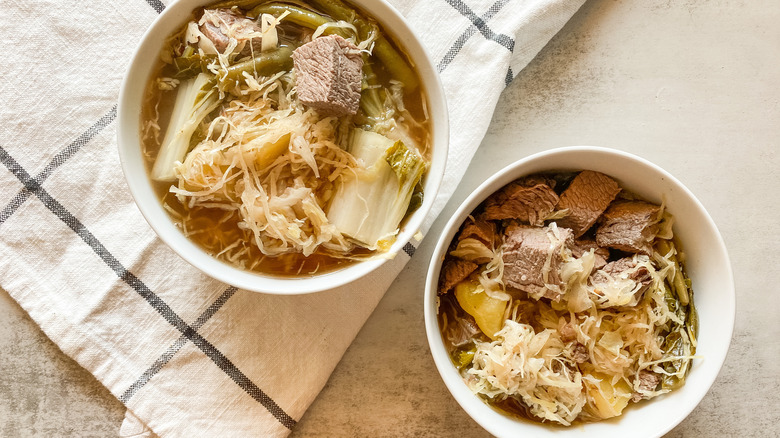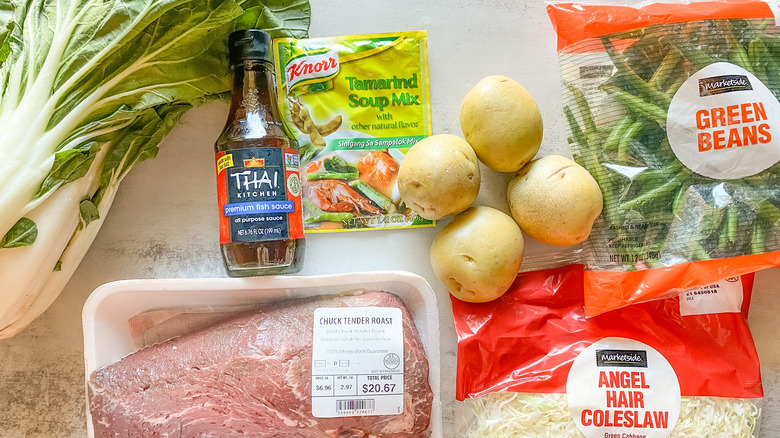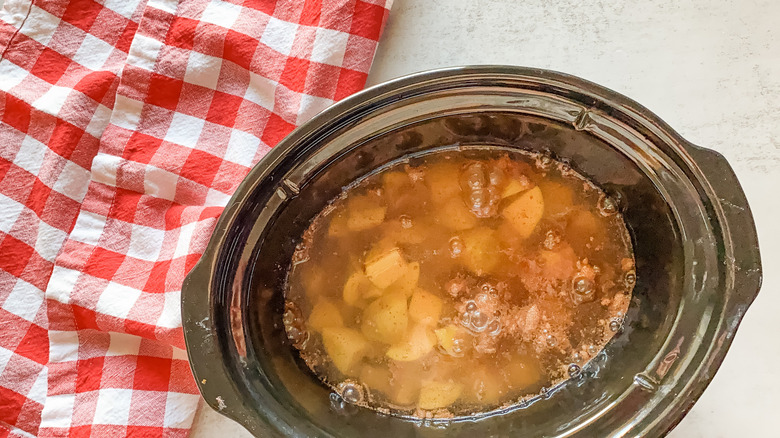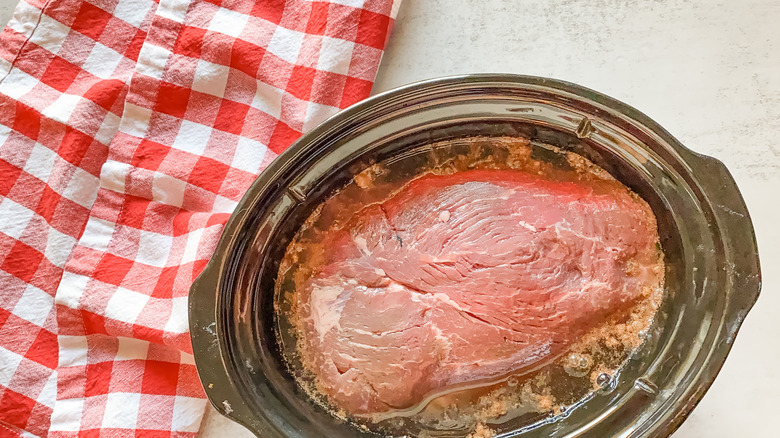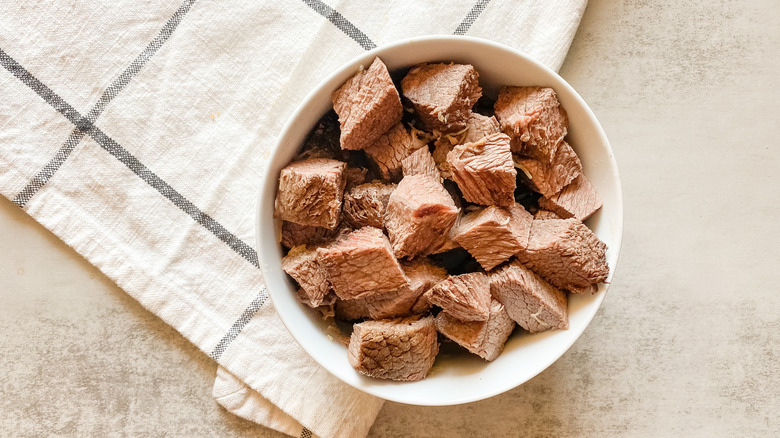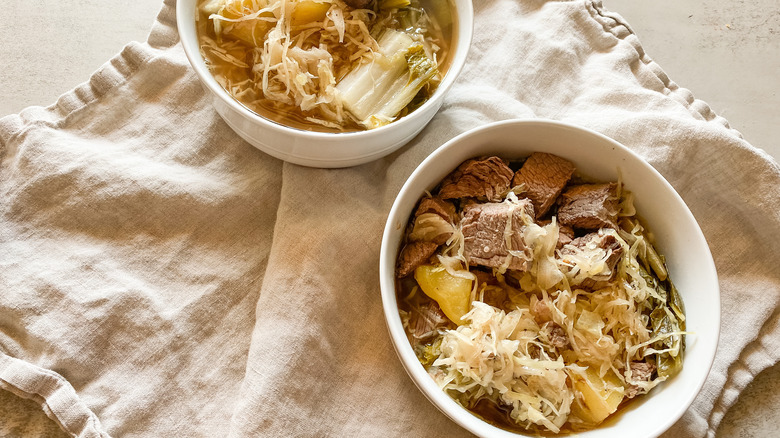Slow Cooker Beef Sinigang Recipe
Experimenting with different cuisines is the best way to travel far from the comfort of your own kitchen. While some exotic recipes require ingredients and equipment that might not be so easy to come by, others use familiar items in new ways. Sinigang means "stewed dish" in Tagalog, one of the numerous languages spoken in the Philippines. The name is a good indication of the preparation and result of this dish, which is more than worthy of inclusion amongst your favorite hearty stew recipes. Here, slow-cooked meat becomes tender over time, cooking in a wonderfully sour broth along with plenty of vegetables. While the meat and vegetable content can change, that tangy flavor is a common thread among the different versions.
Thanks to recipe developer Kristen Carli of Camelback Nutrition & Wellness, you don't have to hop on an international flight to savor the flavors of sinigang. Carli created a slow cooker beef sinigang recipe which makes the long stewing process infinitely simpler. Once the dish has finished cooking, Carli remarks that "this is eaten as a soup but can easily be paired with rice." Sounds like the perfect comfort food to delight your taste buds!
Gather the ingredients for this slow cooker beef sinigang
Start off by gathering the ingredients needed for this slow cooker beef sinigang. You'll need a piece of beef chuck roast, which some butchers call a shoulder steak. Carli notes that "This cut of beef is ideal since it is tender and pairs nicely with these flavors." The other ingredient that builds complex flavors into this one-pot meal is a packet of tamarind-based sinigang mix. Knorr makes a variety you might find. Carli notes that it does wonders "to master the sour soup taste." Tamarind is a sour and tangy fruit that will help to balance out the rich flavors of the meat. The soup packet contains a few other seasoning elements, including onion and tomato powder. You'll need sufficient water to dilute the concentrated powder, which will also help slow cook the meat.
Carli opts for Yukon gold potatoes to add some starch to this dish and will lend a creamy texture. As far as vegetables go, Carli uses bok choy, a type of Chinese cabbage, and green beans. There's certainly a good variety of textures and flavors that can play well in this sinigang. If you want to experiment, Carli remarks that "eggplant, broccoli, and squash would be delicious."
Finally, load up on umami by adding some fish sauce to this dish. While it might seem pungent alone, it's the perfect touch when added to a rich slow-cooked dish like this tasty beef sinigang.
Add the potatoes, packet of tamarind soup, and water
In the pot of a large slow cooker, add the cubed Yukon gold potatoes, the powdered tamarind sinigang packet, and plenty of water. Even though you'll have cubed them up, the potatoes will still take longer to cook than the other vegetables, which is why they are the first to go in. As a bonus, they'll benefit from the long cooking time by soaking up all of the flavors from the tamarind soup packet.
Add the chuck roast and cook for 4 hours
Add the piece of chuck roast on top of the potatoes. Depending on the cut of meat and the size of your slow cooker you might have to squeeze it in — just remember to go slow, so you don't spill the liquids over the side of the slow cooker crock.
Once the chuck roast is snuggled inside, cover the slow cooker with the lid and set the heat to high. Cook the contents for 4 hours. This will give the large cut of meat plenty of time to cook and tenderize alongside those potatoes.
Cut the beef and cook the vegetables
After 4 hours, add the green beans, bok choy, and angel hair cabbage to the slow cooker. Now, cook it all for an additional hour on high heat.
Once that hour is up, remove the beef from the slow cooker using tongs — be careful, as it's going to be hot! — and transfer it to a cutting board. The cut of beef will be nice and tender at this point, which should make it pretty easy to slice it into bite-sized chunks. Once you've done this, simply pop the pieces of beef back into the slow cooker.
Add fish sauce and serve
Add the fish sauce to the slow cooker and give the contents a quick stir to evenly distribute the ingredients. Now it's ready to serve!
Using a ladle, dish out this tasty beef sinigang into bowls, ensuring that you have a nice mix of beef, vegetables, potato, and broth in each serving. Carli recommends serving it alone as a soup or with a side of white rice to help soak up some of the extra stew juices.
Since this does make 10 servings, you may be left with some extra beef sinigang at the end of the process (though, given the taste, plenty of people will be asking for seconds). If you have them, store the leftovers in an airtight container for 3 to 4 days in the refrigerator.
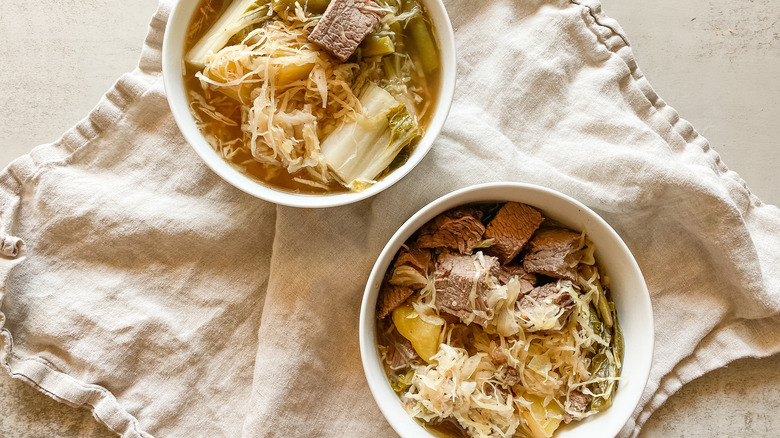
- 4 small Yukon gold potatoes, cubed
- 1 packet tamarind based sinigang
- 6 cups water
- 3 pounds beef chuck roast
- 1 pound green beans, halved
- 1 head bok choy, chopped
- 10 ounces angel hair cabbage
- 1 tablespoon fish sauce
- In a large slow cooker, add the cubed potatoes, packet of tamarind sinigang, and water.
- Add the chuck roast to the slow cooker. Cover the cooker with the lid and cook on high for 4 hours.
- Remove the lid and add the green beans, bok choy, and cabbage. Cover again and continue to cook for 1 hour.
- Using tongs, move the beef to a cutting board and slice it into chunks.
- Add the beef back into the slow cooker.
- Add the fish sauce and serve.
Nutrition
| Calories per Serving | 259 |
| Total Fat | 7.5 g |
| Saturated Fat | 3.0 g |
| Trans Fat | 0.3 g |
| Cholesterol | 87.1 mg |
| Total Carbohydrates | 17.7 g |
| Dietary Fiber | 3.7 g |
| Total Sugars | 3.4 g |
| Sodium | 261.7 mg |
| Protein | 31.7 g |
